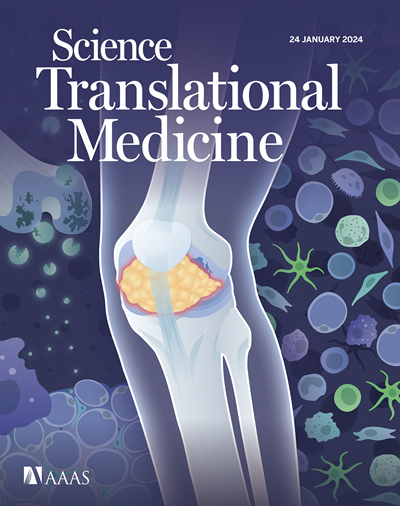2-deoxy 2-[18F]fluorocellobiose 作为曲霉菌特异性 PET 示踪剂的开发和临床前验证。
IF 15.8
1区 医学
Q1 CELL BIOLOGY
引用次数: 0
摘要
过去几十年来,全球侵袭性真菌感染(IFIs)的发病率不断上升,主要发生在免疫力低下的患者身上,而且死亡率和发病率都很高。曲霉菌是最常见、最致命的侵袭性真菌感染病原体之一。治疗真菌感染的主要障碍仍然是缺乏快速和明确的诊断,包括经常需要进行侵入性手术来提供微生物学确认,以及结构成像方法缺乏特异性。为了开发一种曲霉菌特异性正电子发射断层扫描(PET)成像剂,我们重点研究了真菌特异性糖代谢。我们对已知曲霉菌代谢的二糖--纤维生物糖进行了放射性标记,并通过 2-deoxy-2-[18F]fluorocellobiose ([18F]FCB) 与 2-deoxy-2-[18F]fluoroglucose ([18F]FDG) 的酶促转化合成了 2-deoxy-2-[18F]fluorocellobiose ([18F]FCB),其放射化学收率为 60% 至 70%,放射化学纯度大于 98%,合成时间为 1.5 小时。在烟曲霉肺炎以及烟曲霉、细菌和无菌性炎症肌炎小鼠模型中注射[18F]FCB 两小时后,只有在烟曲霉活体感染灶中才能看到残留的放射性。体外测试证实烟曲霉而非细菌会产生β-葡萄糖苷酶,导致[18F]FCB水解为葡萄糖和[18F]FDG,后者被活真菌保留。否则,母体分子会迅速通过肾脏排出体外,从而导致烟曲霉感染部位的本底放射性较低,靶标与非靶标比率较高。我们的结论是,[18F]FCB 是一种很有前途且可用于临床的曲霉菌特异性 PET 示踪剂。本文章由计算机程序翻译,如有差异,请以英文原文为准。
Development and preclinical validation of 2-deoxy 2-[18F]fluorocellobiose as an Aspergillus-specific PET tracer
The global incidence of invasive fungal infections (IFIs) has increased over the past few decades, mainly in immunocompromised patients, and is associated with high mortality and morbidity. Aspergillus fumigatus is one of the most common and deadliest IFI pathogens. Major hurdles to treating fungal infections remain the lack of rapid and definitive diagnosis, including the frequent need for invasive procedures to provide microbiological confirmation, and the lack of specificity of structural imaging methods. To develop an Aspergillus-specific positron emission tomography (PET) imaging agent, we focused on fungal-specific sugar metabolism. We radiolabeled cellobiose, a disaccharide known to be metabolized by Aspergillus species, and synthesized 2-deoxy-2-[18F]fluorocellobiose ([18F]FCB) by enzymatic conversion of 2-deoxy-2-[18F]fluoroglucose ([18F]FDG) with a radiochemical yield of 60 to 70%, a radiochemical purity of >98%, and 1.5 hours of synthesis time. Two hours after [18F]FCB injection in A. fumigatus pneumonia as well as A. fumigatus, bacterial, and sterile inflammation myositis mouse models, retained radioactivity was only seen in foci with live A. fumigatus infection. In vitro testing confirmed production of β-glucosidase enzyme by A. fumigatus and not by bacteria, resulting in hydrolysis of [18F]FCB into glucose and [18F]FDG, the latter being retained by the live fungus. The parent molecule was otherwise promptly excreted through the kidneys, resulting in low background radioactivity and high target-to-nontarget ratios at A. fumigatus infectious sites. We conclude that [18F]FCB is a promising and clinically translatable Aspergillus-specific PET tracer.
求助全文
通过发布文献求助,成功后即可免费获取论文全文。
去求助
来源期刊

Science Translational Medicine
CELL BIOLOGY-MEDICINE, RESEARCH & EXPERIMENTAL
CiteScore
26.70
自引率
1.20%
发文量
309
审稿时长
1.7 months
期刊介绍:
Science Translational Medicine is an online journal that focuses on publishing research at the intersection of science, engineering, and medicine. The goal of the journal is to promote human health by providing a platform for researchers from various disciplines to communicate their latest advancements in biomedical, translational, and clinical research.
The journal aims to address the slow translation of scientific knowledge into effective treatments and health measures. It publishes articles that fill the knowledge gaps between preclinical research and medical applications, with a focus on accelerating the translation of knowledge into new ways of preventing, diagnosing, and treating human diseases.
The scope of Science Translational Medicine includes various areas such as cardiovascular disease, immunology/vaccines, metabolism/diabetes/obesity, neuroscience/neurology/psychiatry, cancer, infectious diseases, policy, behavior, bioengineering, chemical genomics/drug discovery, imaging, applied physical sciences, medical nanotechnology, drug delivery, biomarkers, gene therapy/regenerative medicine, toxicology and pharmacokinetics, data mining, cell culture, animal and human studies, medical informatics, and other interdisciplinary approaches to medicine.
The target audience of the journal includes researchers and management in academia, government, and the biotechnology and pharmaceutical industries. It is also relevant to physician scientists, regulators, policy makers, investors, business developers, and funding agencies.
 求助内容:
求助内容: 应助结果提醒方式:
应助结果提醒方式:


